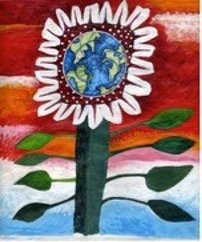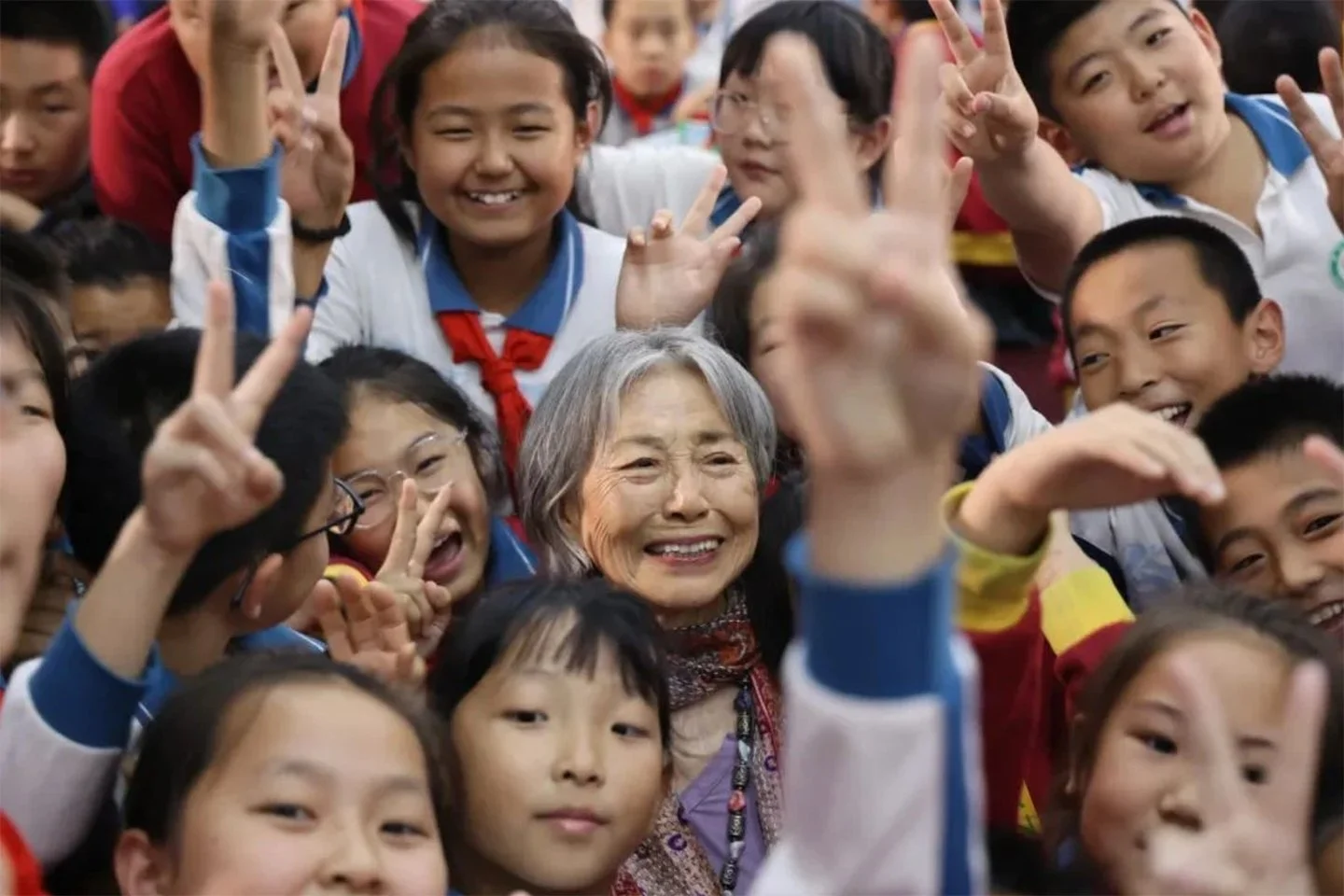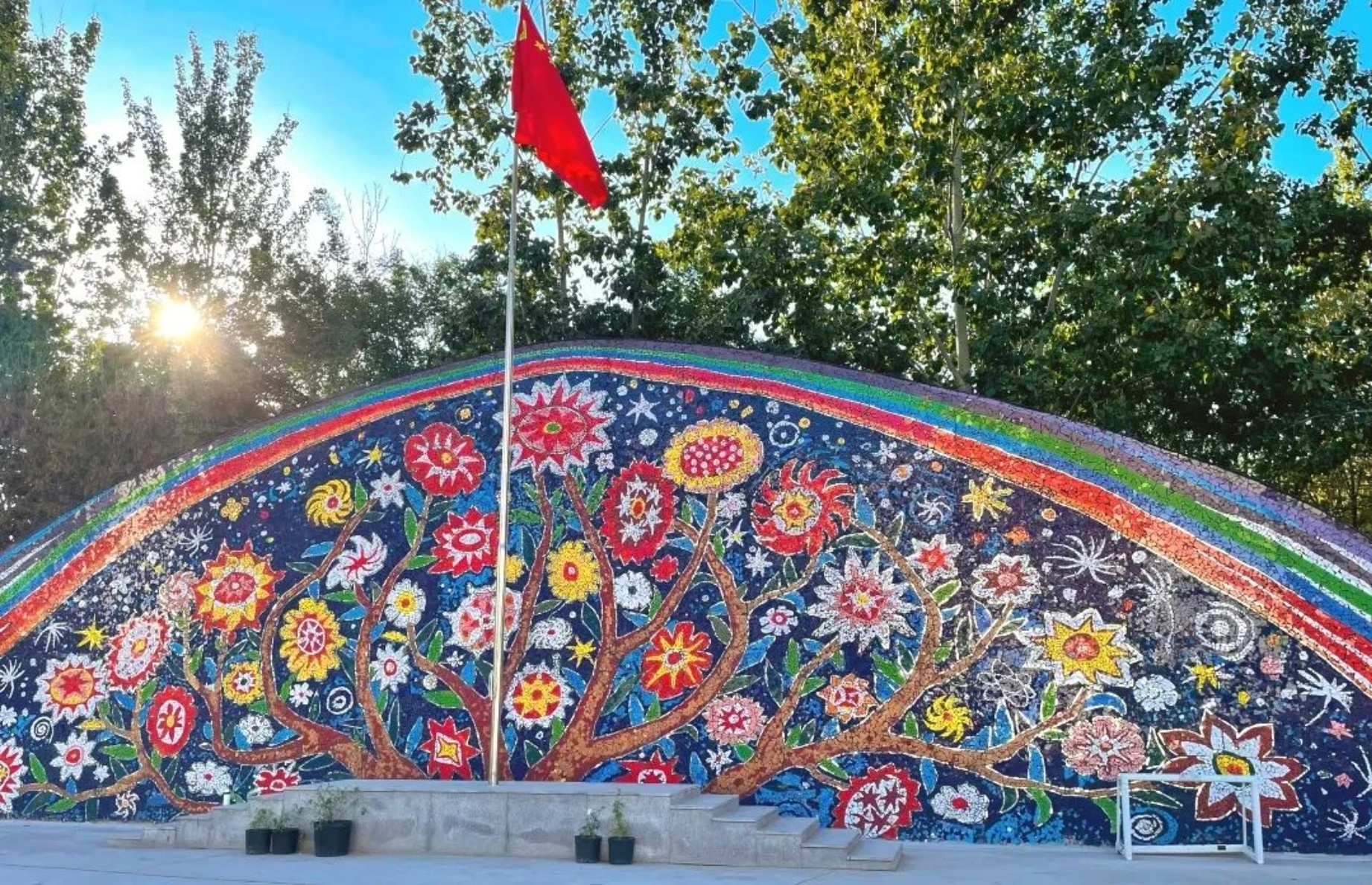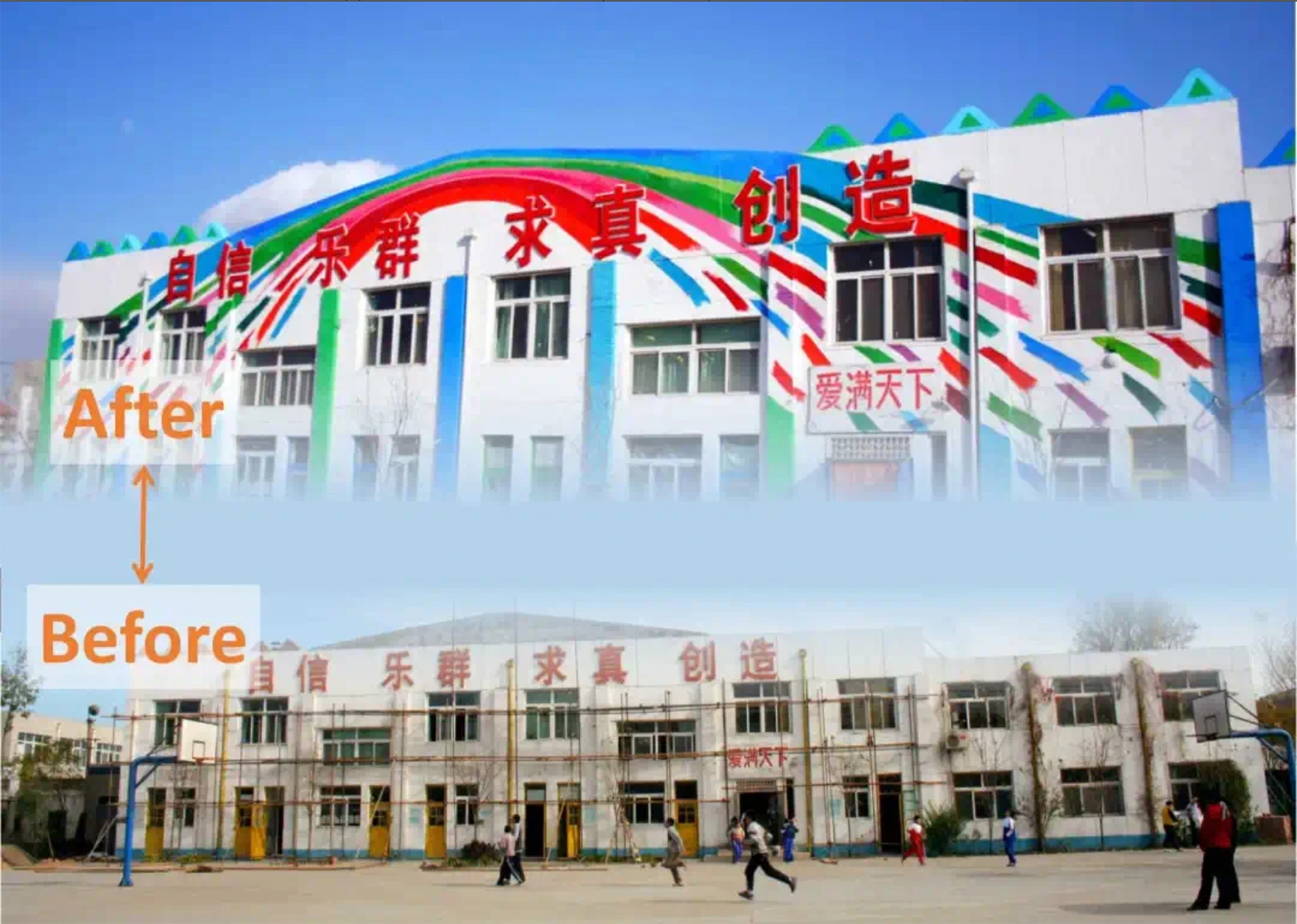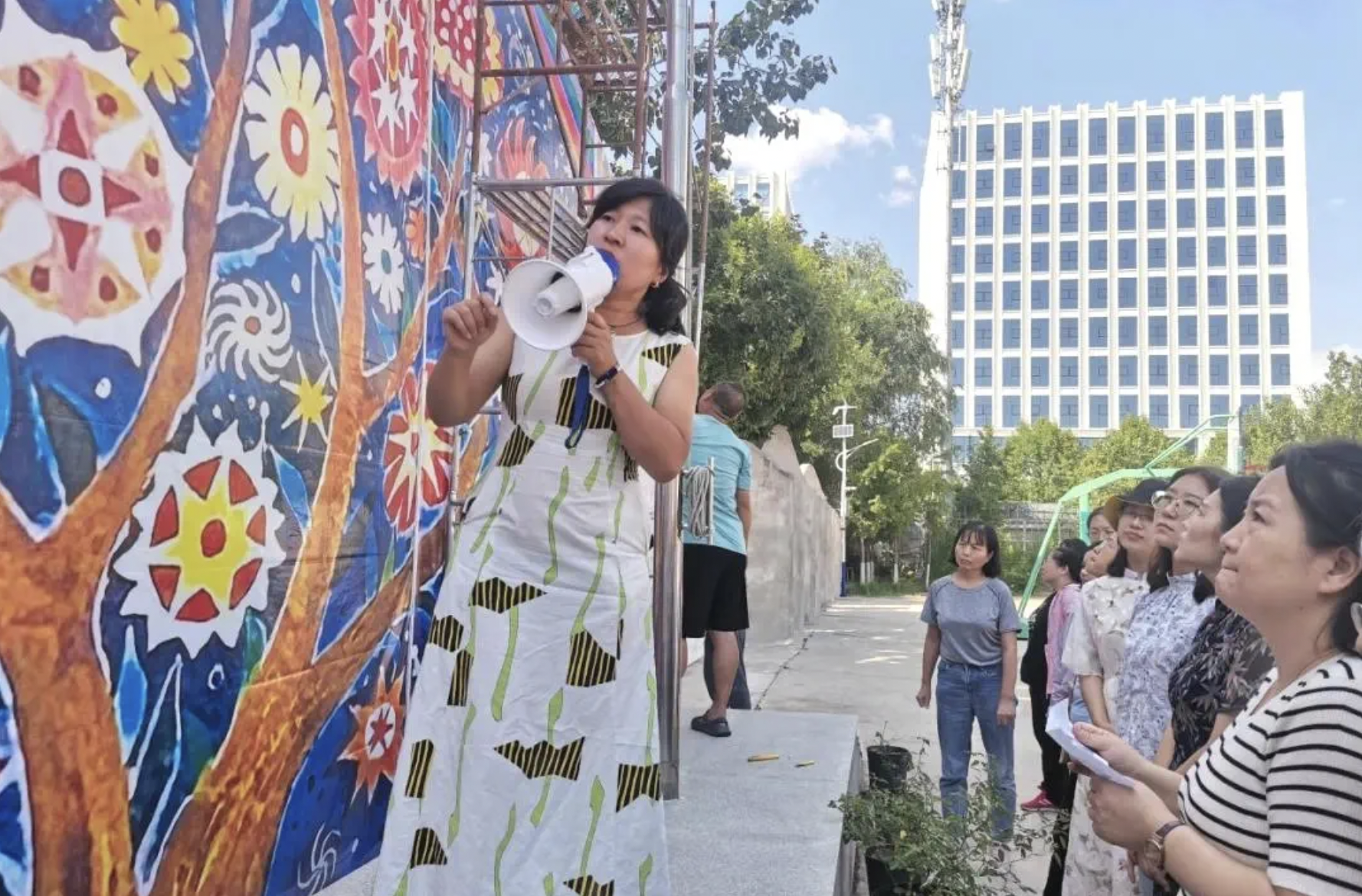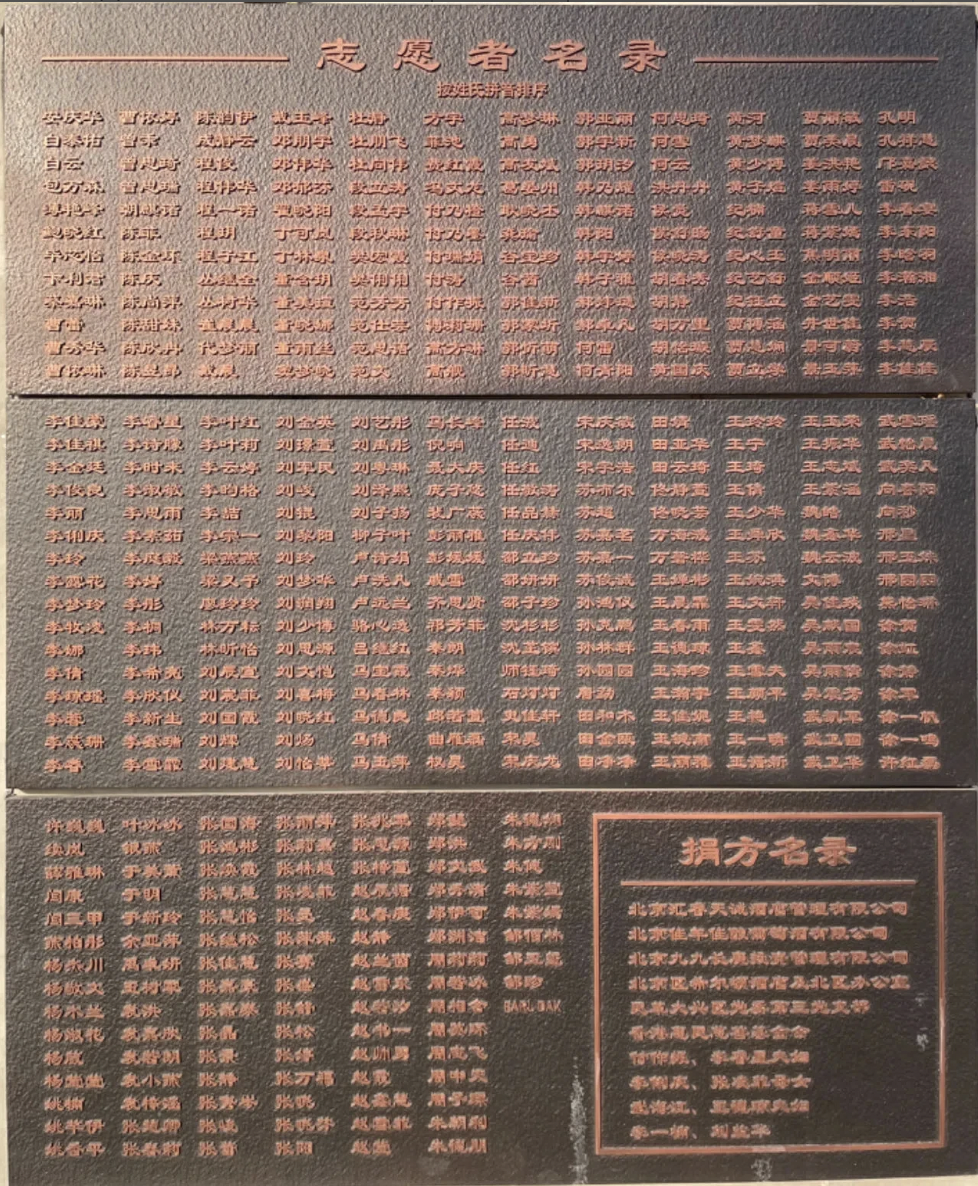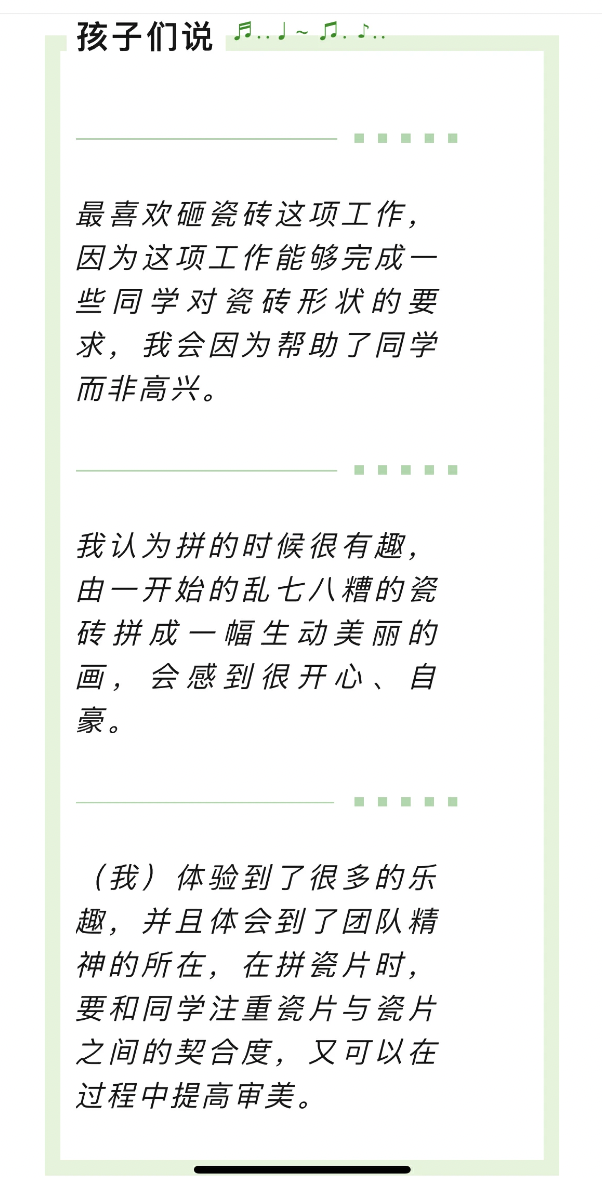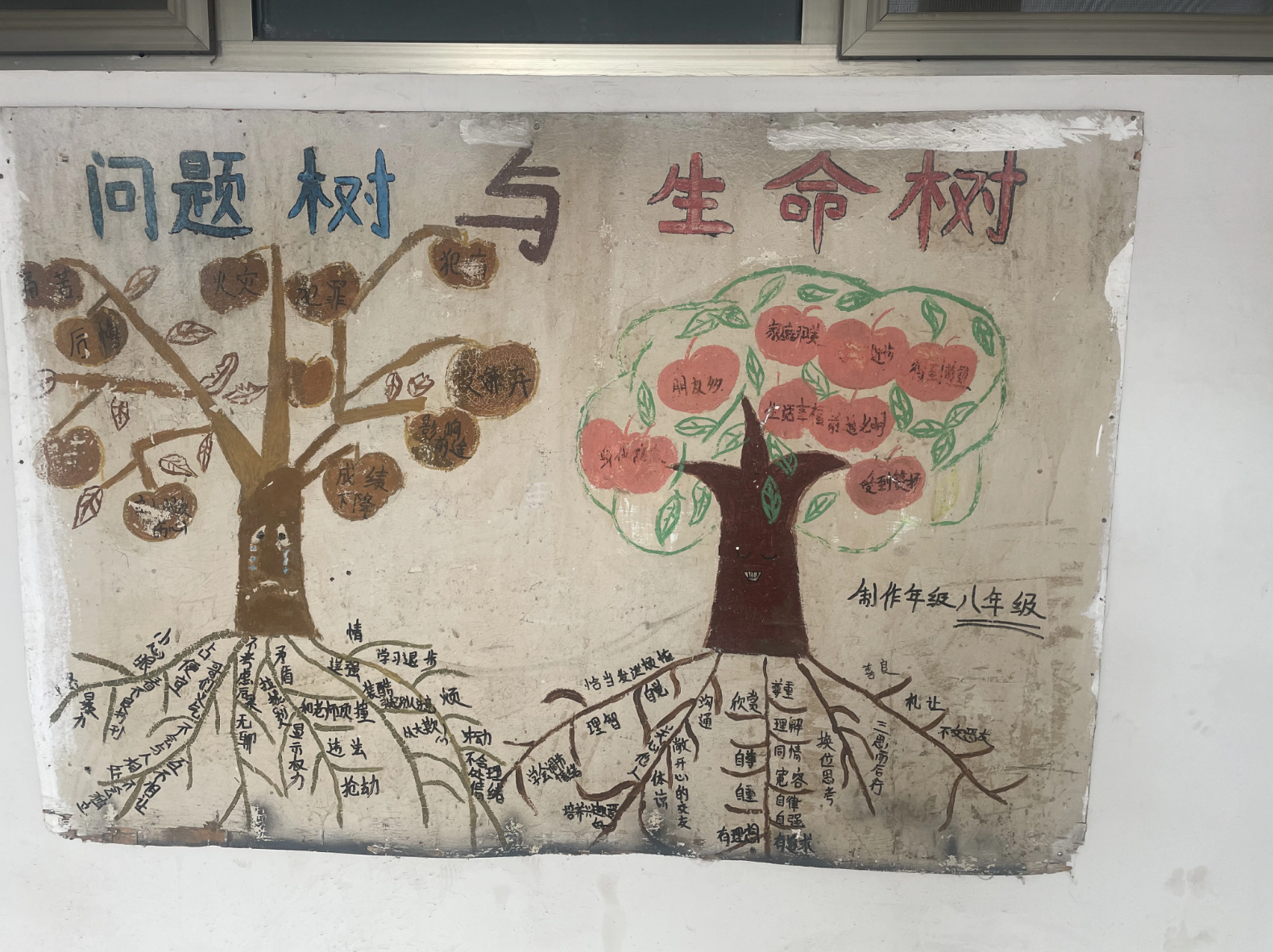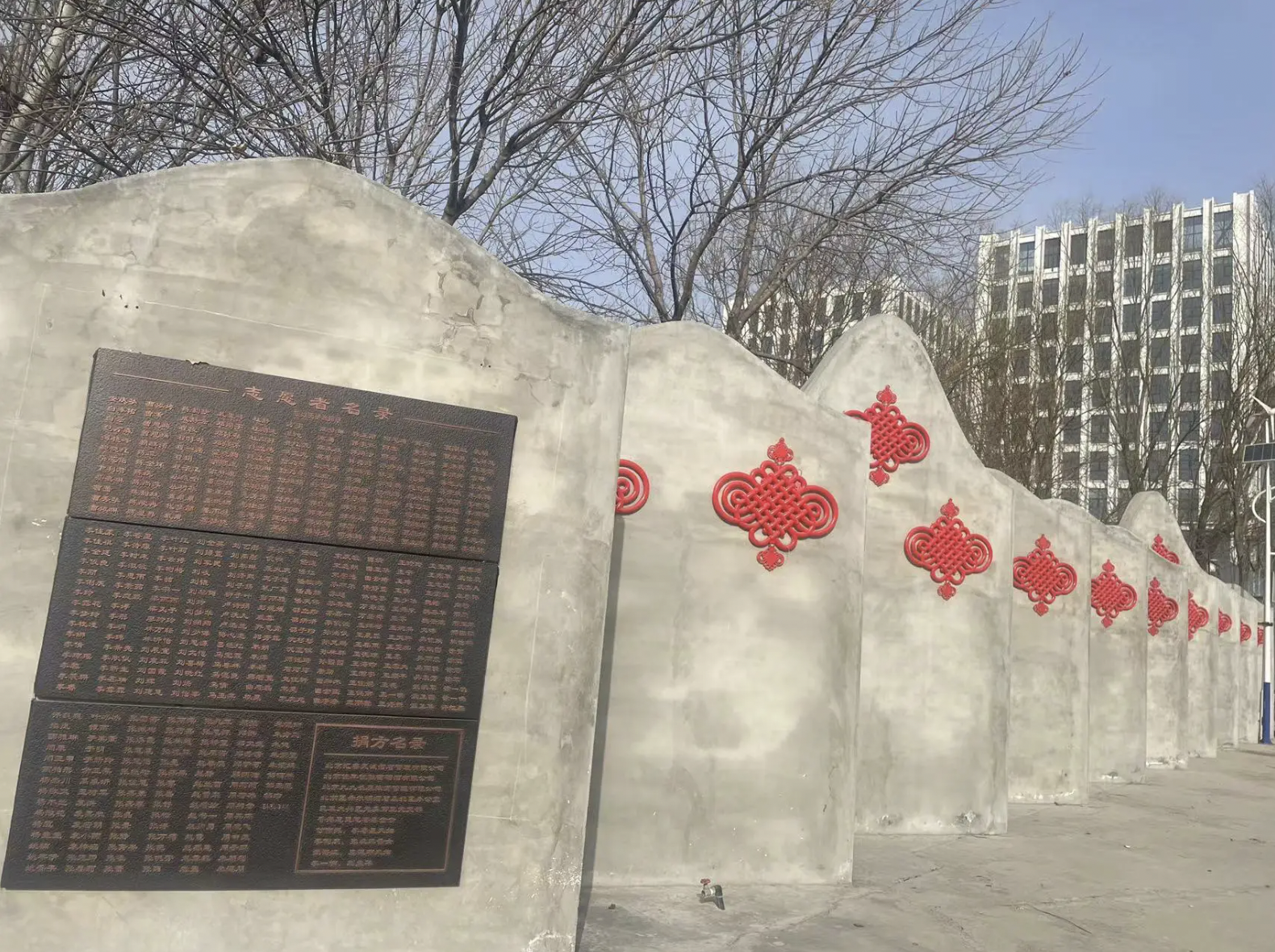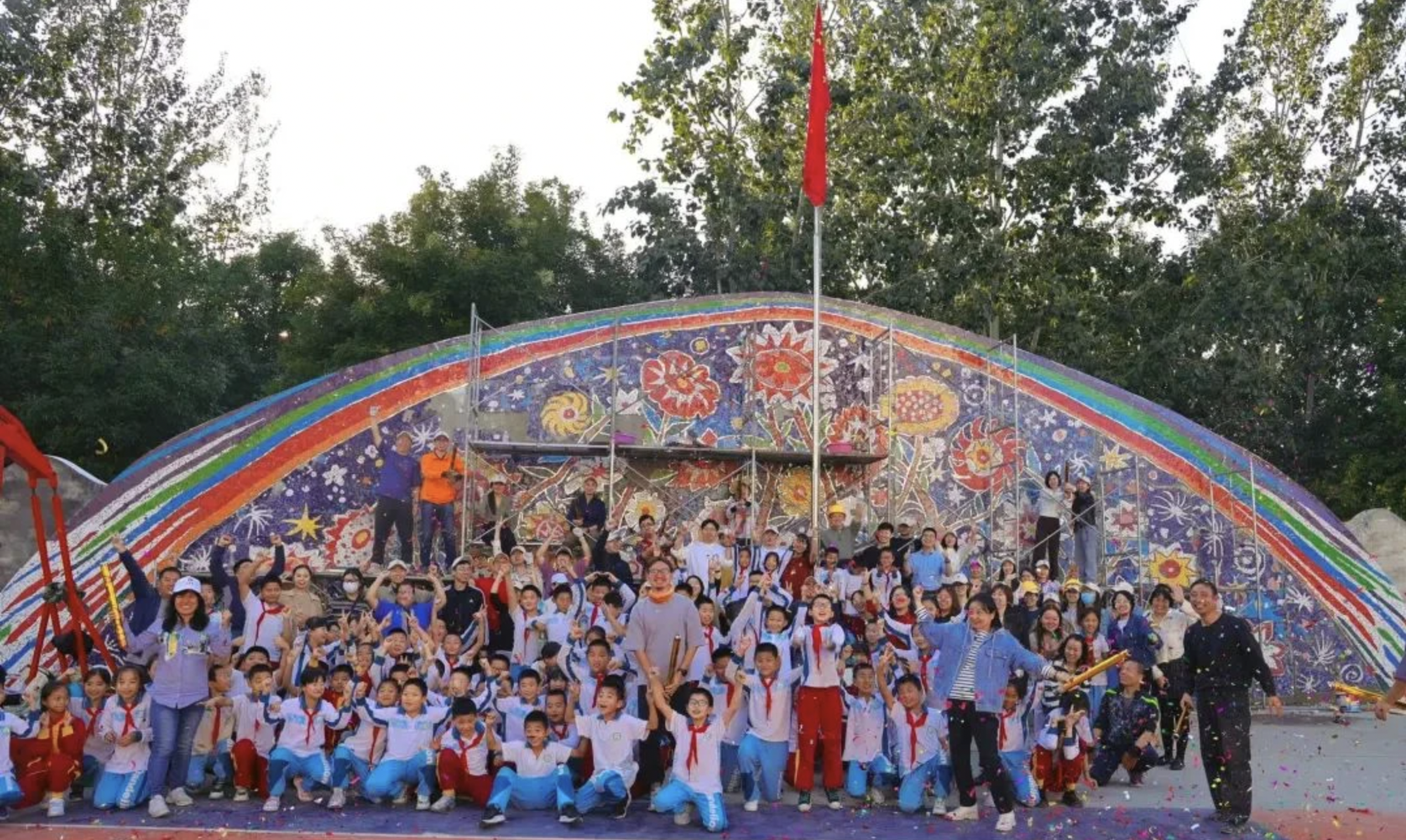How do flowing "dandelions" grow and thrive?
Written by Wuzi. Translated from the original article in Chinese.
Pictures/Except for those with signatures, all are from the WeChat
public account of Dandelion Middle School
At Beijing Dandelion Middle School, a nearly 18-year-long "Environment to Soul Transformation Project" has witnessed the growth of this public welfare, non-profit school due to the "Aesthetic Education Immersion Campus" program. We tried to use the growth process of "A Rainbow Tree of Life" at Dandelion Middle School to let the leader behind this project, the well-known Chinese social art educator, Teacher Lily Yeh, show an admirable energy. As an indispensable long-term volunteer representative of Dandelion Middle School, what special value will her continuous aesthetic education action have? What impact has it had on the teaching work of all subjects in the school? In the process of "art co-creation" advocated and practiced by Teacher Yeh, what role did she play?
Introduction to the activist
Lily Yeh with Dandelion students. She is a social art educator and founder of the American non-profit art organizations Barefoot Artists and The Village of Arts & Humantities
Beijing Dandelion Middle School (hereinafter referred to as "Dandelion") is a private junior middle school specially established for migrant children (currently also enrolls some children in grades 4 and 5 of the primary school stage). Since the school’s beginnings in 2006, the "From Environment to Soul Transformation Project" led by Chinese social art educator Lily Yeh has been a central component of the school’s development. Described as a campus aesthetic education practice, the project has lasted for nearly 18 years and has brought an indispensable spiritual power to the Dandelion students who have drifted from Beijing to the world.
Lily Yeh, who calls herself a "barefoot artist", is a good friend of Zheng Hong, the founding principal of Dandelion. Dandelion teachers and artists say "she may be small, but she is an artist of enormous energy" and describer her as "a teacher with contagious enthusiasm who can discover everyone's shining points and inspire everyone's artistic potential."
The biggest feature of the "Environment to Soul Transformation Project" is the co-creation of art. Yeh says that of all her works at Dandelion, "50% are her own designs, and 50% are everyone's participation." Students and other participants generate the raw materials which she then refines through her perspective and talents as a professional artist with nearly 6 decades of experience.” She is particularly adept at using mosaics. She says “mosaic is a broken pattern, and beauty must be created in the brokenness." By transforming the environment of the community, the people living in it can be changed. From The Village of Arts and Humanities in Philadelphia, USA, to the Rwanda Healing Project in Kenya, to the reconstruction of the campus of Beijing Dandelion Middle School, all embody Yeh’s assertion that “Art should be as tolerant as a big tree, and beauty can be like a tree root, rooted in every corner of life."
The main teaching building of the new campus of Dandelion Middle School
with one of Yeh’s murals in the foreground.
The growth of a "Rainbow Tree of Life"
Walking into Dandelion Middle School, located near Lao Sanyu Park in Xihongmen Town, Daxing District, Beijing, it is easy to see the mural of the tree of life standing at the south gate, which complements the slogan "Love the World" on the main teaching building. Walking to the playground not far away, you can see the huge "Rainbow Tree of Life" mosaic designed by Yeh which is an important continuation and practice of the "From Environment to Soul Transformation Project" in the new Dandelion campus. This is a 20-meter-long elliptical semicircular art work, with a maximum height of 6 meters and a total area of more than 100 square meters. It took 59 days to complete the mosaic, led by three Dandelion art teachers Pei Guangrui, Yin Yan, and Geng Xiaopi, 593 teachers and students of the school and 320 off-campus volunteers. As Teacher Yeh repeatedly emphasized, "Without the help of all the enthusiastic teachers, students and volunteers, this project would have been difficult to complete successfully in such a short time."
Why is it the "Rainbow Tree of Life"?
Everyone who has paid attention to Dandelion will be familiar with the "Tree of Life". From the old campus that was originally transformed from an abandoned factory building to the new campus that has been relocated and rebuilt, the "Tree of Life" is everywhere in the Dandelion campus. The earliest image of the "Tree of Life" was fixed in a mural on the old campus of Dandelion. The dandelion flower painted by student Tang Yakun stretched into the air with lush branches and leaves, becoming the root body of the tree of life... It is also from this image that Dandelion's "Tree of Life" symbolizes the state of each child, the foundation being the individual's life experience and the trunk stretching into the future. Just as Teacher Yeh said, "Every child of Dandelion is a tree of life. They are rooted in the soil of their own hearts and local culture, and then slowly grow, with branches and leaves spreading out. They are completely open, absorbing fresh air, sunlight, and nutrients from everywhere, and picking stars and bright moons in the sky. The children's tree of life can bloom and bear fruit, and a good environment can be created."
The original dandelion "Tree of Life" mural can now only be hung on the wall of the new campus
in the form of a picture (By Wuzi)
The process of each "tree of life" blooming is also the "transformation project from environment to soul" taking root and growing step by step in Dandelion.
In the early stage of creation, we need to listen to the children's beautiful imagination of the campus and strive to turn the beauty into reality. Students will express their desire to see "trees, flowers, birds, sun, rainbows and grass" on campus at the open meeting. Teacher Ye did not simply give his own answer, but took pictures of some very simple places in the school and asked the students to think about how to transform them. The "Rainbow Building" in the old campus, which impressed the art group leader Yuan Xiaoyan and art teacher Pei Guangrui, was the bold creativity of a student. "This student suggested painting a big rainbow on the originally gloomy teaching building," Pei Guangrui said, "Everyone thought it was a good idea at the time." In the end, it was also Teacher Ye who led the teachers and students of the whole school to paint a huge "rainbow rain" emitting colorful light on the roof of the 2-story, 60-meter-long rectangular teaching building, and extended it to the ground... This "rainbow", like the tree of life, has become a favorite work of teachers and students. "They always feel that the rainbow is smiling at them when they go in and out."
The "Rainbow Building" of the old campus
老校区的“彩虹楼”
In 2018, when Dandelion moved to the new campus, teachers and students missed the tree of life and the rainbow building in the old campus. Ye Leilei wanted to bring both the rainbow and the tree of life to the new campus. "I happened to have the opportunity to design a large wall on the west wall of the school, so I put the tree of life under the rainbow, so that the rainbow and the tree of life in the new campus and the old campus have continuity."
Art that everyone can express
When she first came into contact with mosaic inlay in the old campus, Pei Guangrui felt that Teacher Ye had designed it, and everyone working together was co-creation. The more she participated in it, the more she realized the meaning of co-creation that Teacher Ye said. In this renovation project of the west wall, Pei Guangrui, as the technical person in charge, will provide technical training for volunteers and provide certain standards for reference, such as "what color tiles are used for tree trunks, flowers, and the sky; how to collage lines and contours to make them smooth, etc." However, in the actual operation process, it is still found that there are many creative moments that require teachers, students, and volunteers to take the initiative. The length of the mirror, the size of the tile, the curvature of the line... Everyone needs to use their own aesthetic judgment and understanding to decide how to make every detail better. "In this co-creation, nearly a thousand teachers, students and volunteers participated in it, and everyone contributed their own strength." Whether it is faculty and staff and their families, former Dandelion graduates, or students' parents, donor teams, and college students who came here to admire the project, they all called on friends to support. "Without the intervention and support of this kind of social force, our Western Wall project would not have been successfully completed in just 59 days."
Pei Guangrui provides training for teachers involved in mosaic collage
Art teacher Yinyan led students to create
In this massive group creation project, every participant is learning to understand the meaning of being a "tree of life", that is, art can change the environment through community and interaction, and then purify the soul. As English teacher Li Muling repeatedly emphasized, "Most of us who participated are not from art majors, but in this process we can find things within our capabilities. Everyone is willing to participate and is very happy." Just like Chef Chen Jinhuan from the school cafeteria said, "Although I only help when I am free, I can remember the tiles I knocked, and I knocked them well. Whenever I pass by that wall, I want to touch it." There is also Chef Zhang Zhaojun who solved many technical problems. He believes that "everyone is doing their part and can feel that this is a meaningful thing." And more volunteers "see every brick, from the ground, from the hands to the wall, and the brilliant effect presented in the end, is exciting."
List of all volunteers engraved on the west wall.
In the eyes of those who have participated in the growth process of this "Rainbow Tree of Life", the final work may not be "perfect", but because it condenses the efforts of everyone, its vitality is more vigorous and can infect others.
Education happens in co-creation
For Dandelion, the mosaic of the rainbow tree of life on the west wall is not only a construction project, but also an educational project.
Art teachers need to provide relevant training to teachers and students. "We divided the huge canvas of the Rainbow Tree of Life into 598 small squares of 40cm*40cm. Each class and teaching and research group was assigned 2-4 squares, and each of them collaged them, and finally formed a large picture." Pei Guangrui said, "We treat it as a real project-based learning. Children need to understand the whole process from paper draft to wall, from knocking tiles, collage, pasting to wiping tiles, and other details to pay attention to, and also consider the load-bearing capacity of the wall. There must also be a craftsman spirit, and children need to understand where to modify and adjust, etc. The children not only did some pasting work, but began to understand the beauty of mosaic art, understand what processes are needed to complete a real project, and also appreciate the meaning behind the Rainbow Tree of Life." In this process, the teacher led the students to first understand the origin and meaning of the Tree of Life, understand the value of community art done by Teacher Ye, and learn to look at the colors and lines of the Rainbow Tree of Life from an artistic perspective, learn the creative techniques of mosaic art, and so on.
What is gratifying is that the children did gain different experiences. Some people experience joy and happiness, some experience the power of teamwork, some discover another form of art, and some find that this process inspires themselves.
Teacher Yeh and Teacher Geng Xiaopi guide students to make collages.
Some testimonials from students.
When this power of co-creation penetrates into the hearts of teachers and students of Dandelion, creativity will occur everywhere. From the old campus to the new campus, in the process of Dandelion's continuous beauty, every work on campus is not signed by a certain person, but is created by everyone together. "From environment to soul" has become an immersive campus culture and a powerful tool for education.
The first mural work moved to the new campus in 2018 was printed with the handprints of parents and volunteers who came to help, also forming the shape of a "Tree of Life". It was not planned in advance, nor was it deliberate; it happened completely naturally at that time and place.
On the wall of the old campus, there are always many pictures of "problem tree" and "life tree". The future life direction of students is summarized as "problem tree" and "life tree". The roots of "problem tree" are written with some bad behaviors: showing off, disrespecting others... The withered branches are covered with dry leaves and fruits, and they are written with "no friends", "no future", "academic backwardness", etc.; "life tree" is bright in color, with green leaves and red fruits, full of vitality. On the thick roots are written: love learning, respect teachers, love classmates, don't say bad words... On the leaves are: have a bright future, have many friends, don't let teachers down, don't let parents down, full of hope for the future, etc. Through this creation, Dandelion created its own school-based curriculum - "Analysis of Problem Tree and Life Tree". The first class after enrollment allows children to think about themselves and their future and be responsible for themselves. The academic level of freshmen in the first grade of junior high school may only be that of the third or fourth grade of elementary school, but when they graduate three years later, more than 70%-80% of the children will be able to enter high school.
One of the "Problem Tree" and "Life Tree" drawing boards brought by teachers from the old campus.
Behind this transformation, there is a very important teaching concept of Dandelion, "Everyone can lead". Qin Ying, the current executive principal who joined Dandelion in 2007, said, "In Dandelion, people's development is never restricted, and teachers and students can fully exert their abilities." Thanks to the social forces that have continued to pay attention to and support Dandelion for many years, the children here can get a lot of good external learning resources, just like "everyone is an artist" in the transformation of the campus environment, and "everyone can lead" in life and study, and strive to achieve immersive exploration and learning. "Dandelion has many different theme activities every year, and also has more than 20 different art clubs, guiding children to discover their own advantages and be the best of themselves."
It is worth looking forward to that in addition to the completed middle section decoration, there are 22 short walls extending to both sides of the west wall of Dandelion. In the planning of Qin Ying and Dandelion teachers, these blank walls will be left for the children of Dandelion to complete. "It will be designed in combination with the school's art courses. I believe they will definitely bring more beautiful creations."
A blank short wall waiting for the dandelion children to complete (Photo credit: Wu Zi).
Dialogue: How can aesthetic education permeate campus?
Gong Yu (Initiator & Executive Committee Representative of Rural Children's Aesthetic Education Network, Co-founder & Chairman of Beijing Xinyidong Social Work Development Center, hereinafter referred to as "Gong")
Qin Ying (Executive Principal of Dandelion Middle School, hereinafter referred to as "Qin")
Pei Guangrui (Art Teacher of Dandelion Middle School, hereinafter referred to as "Pei")
Bao Xiaohong (Mathematics Teacher of Dandelion Middle School, hereinafter referred to as "Bao")
Li Muling (English Teacher of Dandelion Middle School, hereinafter referred to as "Li")
Gong: Dandelion has received support from many volunteers, and Teacher Ye Leilei is one of the people who has participated the longest! What do you think is the different value of this long-term support compared to short-term attention?
Qin: Regarding the influence of Teacher Ye on the school as a long-term volunteer, I think it can be summarized in two words. The first is "inheritance". Teacher Ye has been doing "from environment to soul" since the establishment of Dandelion. This long-term cooperation is because everyone is very compatible and mutually recognized in terms of concepts. Over the years, both teachers with a long teaching experience (several teachers present here) and new teachers have always inherited this concept. The second is "deepening". Long-term volunteers like Teacher Ye have been accompanying the growth of Dandelion and have continuously deepened its connotation throughout the development of the school. Teacher Ye's continuous support for the school is also a firm force for Dandelion to move forward. As teachers, we feel that having such volunteers to support the growth of the school for a long time is an affirmation of Dandelion, and also a special affirmation of our profession of teaching and educating people.
Pei: Teacher Ye is like our family, and her influence on us is continuous. It is this long-term support that makes our cognition and understanding of art change with her continuous actions. This is also a kind of infiltration power, a process of continuous advancement and internalization.
Bao: If short-term volunteers may bring a point of light, the light brought by Teacher Ye is more lasting and also has transmission. The environmental renovation project done by Teacher Ye in the school allows every student to actively participate in it, allowing them to personally experience the initial impossibility and then become a reality, which will also make them believe that "everything is possible". The mosaic painting created by Teacher Ye, the spirit of "creating beauty from brokenness", can make students understand that as long as you work hard to create and splice, it will become beautiful and make life powerful.
Teachers and students of Dandelion celebrate the completion of the Western Wall project.
Gong: In conjunction with the "aesthetic education immersion campus" plan recently proposed by the Ministry of Education, immersion is actually all-round. In addition to art teachers, what impact has Teacher Ye's long-term support "from environment to soul" had on the teaching work of other subject teachers?
Li: Teacher Ye made us understand that you have to love your students. When you get along with students, when they have questions, when they can't understand this or that, we should be more patient in our hearts. I often tell students "I'm not afraid of asking too many questions, I'm afraid you don't ask." Students will be very relaxed in my class, and teachers will not criticize them casually. When studying in Teacher Ye's workshop, and when we all participated in various campus environment renovation projects, we never thought "I don't have an art foundation, so I can't participate." Everyone has a chance and can do well. Teacher Ye will praise everyone confidently, and we can also feel that this praise comes from her heart. This also teaches us to see the shining points in others. This can also be used in the classroom, and the relationship with students will get better and better.
Qin: I agree with what Teacher Li said. Teacher Ye always encourages everyone when she does workshops with us. This is closely related to our teaching philosophy. We often encourage teachers to look at students with appreciation. Working with a senior like Teacher Ye will make you feel safe. As a teacher, how we create a very safe environment in the classroom where students can calm down and create is very important for their growth and learning.
In addition, Teacher Ye's concept of co-creation of art also opens up a good perspective for us. Through co-creation and cooperation, everyone learns from each other, learns from each other's strengths and grows together. Teacher Ye once said in a lecture that "you should give others a light", and she did it. When each of us thinks of Teacher Ye, we will feel very kind and it will bring us a particularly strong power. The character she possesses is worth learning from all our teachers and students.
Bao: The magical thing about Teacher Ye is that she will turn every participant in every creation into a protagonist, especially making students the core. This will also give me some reference in teaching mathematics.
For example, when I need to summarize the course content at the end of each chapter, I will ask students to summarize the course content in groups, let them discuss the knowledge they have learned in groups, and then give a rough framework, and then put the framework on the blackboard. I will ask them to divide the framework into blocks, and each person will perfect the content of this small block in this chapter, just like Teacher Ye's mosaic. At this time, all the initiative is given to the students, and I will watch how the students brew, combine and fill, and finally let each group of students share on the podium. I think this kind of class is completely student-centered. They have to design and discuss "how to do it, how to share, who will share, what to share..." My students also prefer this type of class. Generally, such a course is two class hours, about 80 to 90 minutes.
In fact, our classes are similar. Our teaching philosophy is the same as Teacher Ye's co-creation. When Teacher Ye led us to create, she only talked about how to do it roughly. More details and specific execution were done by the children. The teacher's job was to "add the finishing touch". In class, we also asked questions to let students think divergently, and then took them back to let them think.
Gong: What role do you think Teacher Ye played and what did she do in the co-creation art activities?
Qin: I think she gathered the energy of more people! Including in the old campus, a student's idea became the "Rainbow Building". Later in the new campus, we still wanted to have a rainbow, but there was no place to draw a rainbow, so we turned the glass of the teaching building into colored glass. Teacher Ye can turn everyone's ideas into reality and bring everyone a sense of value, that is, everyone can find their own value in this co-creation process.
Pei: Teacher Ye is the soul figure. She can mobilize everyone's energy and play an important role in the end. We also need a role like Teacher Ye to make such judgments. Just like the mosaic inlay on the west wall, although there is a design draft, the completion of the work after the mosaic collage is actually unknown. It has no fixed template, so we need Teacher Ye to tell us when we can finish and what state represents completion. This ability is not technical. Teacher Ye himself would say that this is a kind of "alchemy". Without the alchemical process, this work may not have the height of art.
